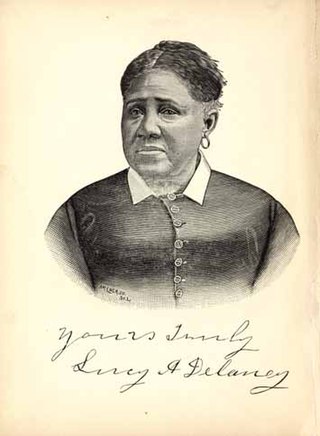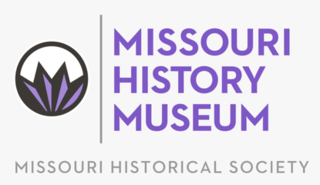
The Missouri Historical Society was founded in St. Louis on August 11, 1866. [1] Founding members created the historical society "for the purpose of saving from oblivion the early history of the city and state". [2] [3]

The Missouri Historical Society was founded in St. Louis on August 11, 1866. [1] Founding members created the historical society "for the purpose of saving from oblivion the early history of the city and state". [2] [3]
The Missouri Historical Society operates the Missouri History Museum in St. Louis' Forest Park, as well as the Library and Research Center. Admission to the museum and library are free to the public.
The Library and Research Center [4] houses a regional history collection documenting St. Louis, the Mississippi and Missouri Valleys, the Louisiana Purchase Territory, and the American West. The Library and Research Center collections include:
No appointment is needed to view the library and manuscript collections, but might be needed for other collections. Among its unique collections are the 301 freedom suits of the 19th-century St. Louis Circuit Court Records, the largest group of such case files in the country. These have been scanned into a searchable database that is online for researchers. They document the slaves' petitions for freedom under state law before the American Civil War. [5]
The research library is housed in a historic 1927 Byzantine revival synagogue building erected by the United Hebrew Congregation on Skinker Boulevard. (The congregation has moved to Chesterfield where it erected a new building.)
The Missouri Historical Society offers programs and outreach services, including traveling exhibitions, tours, theatrical and musical presentations, programs for school classes and youth groups, family festivals, special events, workshops, and lectures.
In 1952, the Missouri Historical Society was involved in efforts to lobby the U.S. government to create commemorative coins for the 150th anniversary of the Louisiana Purchase. [6]

The Louisiana Purchase Exposition, informally known as the St. Louis World's Fair, was an international exposition held in St. Louis, Missouri, United States, from April 30 to December 1, 1904. Local, state, and federal funds totaling $15 million were used to finance the event. More than 60 countries and 43 of the then-45 American states maintained exhibition spaces at the fair, which was attended by nearly 19.7 million people.
Dred Scott v. Sandford, 60 U.S. 393 (1857), was a landmark decision of the United States Supreme Court that held the U.S. Constitution did not extend American citizenship to people of black African descent, and thus they could not enjoy the rights and privileges the Constitution conferred upon American citizens. The decision is widely considered the worst ever rendered in the Supreme Court's history, being widely denounced for its overt racism, perceived judicial activism and poor legal reasoning, and for its crucial role in the start of the American Civil War four years later. Legal scholar Bernard Schwartz said that it "stands first in any list of the worst Supreme Court decisions". Chief Justice Charles Evans Hughes called it the Court's "greatest self-inflicted wound".

Dred Scott was an enslaved African American man who, along with his wife, Harriet, unsuccessfully sued for freedom for themselves and their two daughters in the Dred Scott v. Sandford case of 1857, popularly known as the "Dred Scott decision". The case centered on Dred and Harriet Scott and their children, Eliza and Lizzie. The Scotts claimed that they should be granted their freedom because Dred had lived in Illinois and the Wisconsin Territory for four years, where slavery was illegal, and laws in those jurisdictions said that slaveholders gave up their rights to slaves if they stayed for an extended period.

Forest Park is a public park in western St. Louis, Missouri. It is a prominent civic center and covers 1,326 acres (5.37 km2). Opened in 1876, more than a decade after its proposal, the park has hosted several significant events, including the Louisiana Purchase Exposition of 1904 and the 1904 Summer Olympics. Bounded by Washington University in St. Louis, Skinker Boulevard, Lindell Boulevard, Kingshighway Boulevard, and Oakland Avenue, it is known as the "Heart of St. Louis" and features a variety of attractions, including the St. Louis Zoo, the St. Louis Art Museum, the Missouri History Museum, and the St. Louis Science Center.
Rachel v. Walker (1834) was a "freedom suit" filed in the St. Louis Circuit Court by an African-American woman named Rachel who had been enslaved. She petitioned for her freedom and that of her son James (John) Henry from William Walker, based on having been held illegally as a slave in the free territory of Michigan by a previous master, an Army officer. Her case was appealed to the Supreme Court of Missouri, where she won in 1836. The court ruled that an Army officer forfeited his slave if he took the person to territory where slavery is prohibited. This ruling was cited as precedent in 1856 in the famous Dred Scott v. Sandford case before the Supreme Court of the United States.

Lucy Delaney was an African-American woman, who when she was free was a seamstress, slave narrator, and community leader. She was born into slavery and was primarily held by the Major Taylor Berry and Judge Robert Wash families. As a teenager, she was the subject of a freedom lawsuit, because her mother lived in Illinois, a free state, longer than 90 days. According to Illinois state law, slaves that reside in Illinois for more than 90 days should be indentured and freed. The country's rule of partus sequitur ventrem asserts that if the mother was free at the child's birth, the child should be free. After her mother, Polly Berry, filed a lawsuit for herself, she filed a lawsuit on her behalf in 1842. Delaney was locked up for 17 months in a cold, damp, smelly jail while awaiting the trial.

Hamilton Rowan Gamble was an American jurist and politician who served as the Chief Justice of the Missouri Supreme Court at the time of the Dred Scott case in 1852. Although his colleagues voted to overturn the 28-year precedent in Missouri of "once free always free," Gamble wrote a dissenting opinion. During the American Civil War, he was appointed as the Governor of Missouri by a Constitutional Convention after Union forces captured the state capital at Jefferson City and deposed the elected governor, Claiborne Jackson.

The Missouri History Museum in Forest Park, St. Louis, Missouri, showcases Missouri history. It is operated by the Missouri Historical Society, which was founded in 1866. Museum admission is free through a public subsidy by the Metropolitan Zoological Park and Museum District.

The Louisiana State Museum (LSM), founded in New Orleans in 1906, is a statewide system of National Historic Landmarks and modern structures across Louisiana, housing thousands of artifacts and works of art reflecting Louisiana's legacy of historic events and cultural diversity.
The history of St. Louis began with the settlement of the area by Native American mound builders who lived as part of the Mississippian culture from the 9th century to the 15th century, followed by other migrating tribal groups. Starting in the late 17th century, French explorers arrived. Spain took over in 1763 and a trading company led by Pierre Laclede and Auguste Chouteau established the settlement of St. Louis in February 1764. It attracted French settlers leaving Illinois after their defeat in the Seven Years' War. The city grew in population due to its location as a trading post on the Mississippi River, as the western fur trade was lucrative. The city played a small role in the American Revolutionary War and became part of the U.S. through the Louisiana Purchase in 1803.

The Kentucky Historical Society (KHS) was originally established in 1836 as a private organization. It is an agency of the Kentucky state government that records and preserves important historical documents, buildings, and artifacts of Kentucky's past. The KHS history campus, located in downtown Frankfort, Kentucky, includes the Thomas D. Clark Center for Kentucky History, the Old State Capitol, and the Kentucky Military History Museum at the State Arsenal. KHS is a part of the Kentucky Tourism-Arts and Heritage Cabinet, is fully accredited by the American Alliance of Museums, is a Smithsonian affiliate, and endorses the History Relevance statement. The mission of the KHS is to educate and engage the public through Kentucky’s history in order to confront the challenges of the future. The KHS allows the public access to their resources through the online Library catalog along with the in-person Library.

The State Historical Society of Missouri, a private membership and state funded organization, is a comprehensive research facility located in Columbia, Missouri, specializing in the preservation and study of Missouri's cultural heritage. Established in 1898 by the Missouri Press Association and made a trustee of the state in 1901, the Society is the official historical society of the state of Missouri and is located on the campus of the University of Missouri in Downtown Columbia, Missouri. The Society publishes the quarterly Missouri Historical Review, the only scholarly academic journal produced in the state.

Jean-Pierre Chouteau was a French Creole fur trader, merchant, politician, and slaveholder. An early settler of St. Louis from New Orleans, he became one its most prominent citizens. He and his family were prominent in establishing the fur trade in the city, which became the early source of its wealth.

The Academy of Science, St. Louis is a non-profit organization in St. Louis, Missouri, dedicated to science literacy and education. Founded in 1856 by a group of scientists and businessmen, including George Engelmann and James B. Eads, the Academy has been involved in many science-related activities in the city.

Marguerite Scypion, also known in court files as Marguerite, was an African-Natchez woman, born into slavery in St. Louis, then located in French Upper Louisiana. She was held first by Joseph Tayon and later by Jean Pierre Chouteau, one of the most powerful men in the city.

Freedom suits were lawsuits in the Thirteen Colonies and the United States filed by slaves against slaveholders to assert claims to freedom, often based on descent from a free maternal ancestor, or time held as a resident in a free state or territory.
The following is a timeline of the history of the city of St. Louis, Missouri, United States.
The Arthur F. McClure Archives and University Museum contains a variety of historical documents and artifacts pertaining to the history of the University of Central Missouri as well as containing other collections that focus on larger histories. The archives and museum serves the University of Central Missouri students as well as the general public. The archives are often frequented by individuals researching genealogy as well as students looking for resources on notable events that occurred during the twentieth century.

In the United States, the National Archives facilities are facilities and buildings housing the research and agency services of the country's National Archives and Records Administration. Within the organization of the National Archives, the upkeep of its facilities falls under the National Archives Facilities and Property Management Office.

Robert Wash served on the Supreme Court of Missouri from September 1825 to May 1837. During his term, the pro-slavery judge, who owned slaves himself, wrote the dissenting opinion on several important freedom suits, including Milly v. Smith, Julia v. McKinney and Marguerite v. Chouteau. However, he did join in the unanimous finding for the plaintiff in the landmark Rachel v. Walker case.